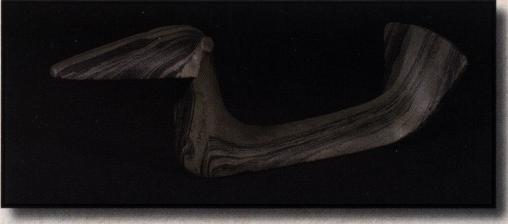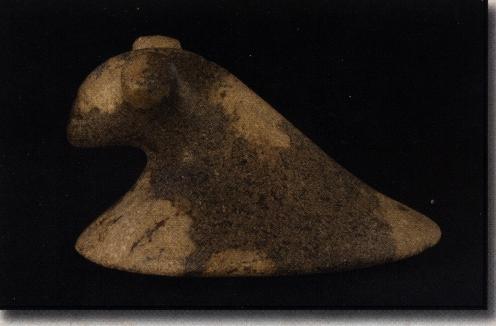1. Elongated Birdstones
Elongated Birdstones comprise the vast majority of all birdstones. Perhaps 75% or more of all birdstones will fall into this category. An elongated birdstone is rather simple in form, typically consisting of a head, neck, elongated narrow body, and a tail. Some elongated birdstones were made with special treatment to the neck and to the tail. Because this type contains such a large number of examples, three subtypes of Elongated are required.
A. Elongated Typical Birdstones
This may be the most difficult type to define. It is easy to state that a birdstone is typical, but typical is very difficult to define. What is typical? A Typical Birdstone has all of the general attributes and characteristics of a birdstone but does not have distinctive characteristics that would place it into one of the other two categories. It does not have a long, exaggerated neck nor does it have a wide fantail. Therefore, it is Typical. Another way to think about or describe a Typical Birdstone is that it has a “common” form. The use of the word common does not in any way detract from its quality or character. Many Typical Birdstones are superb in workmanship and form. They just happen to have the most often seen features and characteristics of a large percentage of birdstones—a typically shaped head, an elongated narrow body, and a tail. Please note that numerous examples may exhibit some form of eyes.

Elongated Typical Birdstone, Allen County,
Indiana, 574″ in length
B. Elongated Fantail Birdstones
The Elongated Fantail Birdstone exhibits a head with or without eyes, a long narrow body, and an expanding tail. A Fantail would be any tail that is wider at the top than at the bottom of the tail or the base of the birdstone. Examples would range from those that are only slightly wider at the top to extreme examples that measure in the two inch range. Some examples may also exhibit the characteristics of the Long Neck Birdstone discussed below.


Elongated Fantail Birdston, Oakland County, Michigan, 678″ in length
C. Elongated Long Neck Birdstones
The Elongated Long Neck Birdstone exhibits a head with or without eyes, a long narrow body and a tail. Where this type differs is in the treatment of the neck. When the length of the neck exceeds the length of the head the birdstone may be described as a Long Neck Birdstone. This may be defined as the measurement from the bottom front of the base to the approximate and neck. Birdstones from the Northeast United States and Ontario, Canada that are commonly referred to as “Boxheads” would routinely fit into this category.


Elongated Long Neck Birdstone, Sandusky County, Ohio 4 5/8″ in length
2. Saddle BirdstonesÂ
Another highly descriptive name that has long been used in the nomenclature of birdstones is the Saddle Birdstone. Looking at a western style horse saddle from the side closely approximates the curves that one would see while viewing Saddle Birdstones from the side. Saddle Birdstones generally have an elevated curvature of the tail and head; however, the tail may sometimes extend straight back with no elevation. Saddle Birdstones have a body width that is greater than the height of the body. This type will generally have a distinct medial ridge that will extend from the tip of the tail and forward to the tip of the beak or head. A casual observation of this type indicates that the wider the body, the straighter the tail. Examples of this type will almost always have eyes, and they may be made from any type of material.


Saddle Birdstone, Calhoun County, Michigan, 378″ in length
3. Bust Birdstones
Like an ancient Roman sculpture of the bust of an emperor, the Bust Birdstone is very similar. The Roman sculpture features a head, a neck, and shoulders (base). A Bust Birdstone is basically the same: a head, neck, and base. Numerous Bust Birdstones are not perforated, but when they are, the perforations are made from the base upward at both the front and the rear. The form of the base varies from round, oval, and teardrop to somewhat square in form. The norm for Bust Birdstone eyes tends toward cylindrical eyes, but other types exist. It is probably true that all Bust Birdstones were meant to have eyes, however, prehistoric breakage and salvage have taken their toll on many.


Bust Birdstone, allegan County, Michigan 3/4″ in length
4. Chunky Birdstones
Although not the most glamorous name for a birdstone type, it is certainly very descriptive of this very easily identifiable type, and the term has been in common usage for generations. The term “chunky” refers to the heavy structure or character of the body of these birdstones. The body of Chunky Birdstones from the neck to the tail is generally much wider and higher than Elongated Birdstones. The heads are generally small. Generally, the overall length is less than that of Elongated and Long Neck types. Also the weight or mass of Chunky Birdstones frequently exceeds that of other types even though the overall dimensions are smaller. Although Chunky Birdstones often do not have eyes, there are many that do. Numerous examples exhibit eyes that are drilled. Sometimes the drilling is so shallow that the eyes are difficult to discern. Incised mouths are also frequently seen on Chunky Birdstones.


Chunky Birdstone, Kosciusko County, Indiana, 3″ in length
5. Animal Form Birdstones
Animal Form Birdstones are relatively easy to identify and define. As their name implies, this birdstone type has definite characteristics that equate them to various animals other than birds. Although these birdstones have some identifying characteristics to recognizable animals, they almost never have enough identifiers to be able to state emphatically that it is without doubt a certain animal. Often the animal characteristics seen on these birdstone appear whimsical or even bizarre. Generally, Animal Form Birdstones will fall into one of two groups.
A. Animal Gorget Type
Bodies of the somewhat rare Animal Gorget Birdstone group are usually oval in form. They also have a low flattened profile. Many are similar to an oval shaped gorget but exhibit a head and sometimes a tail. However, some have a body form that gently rises from the rear up to the head. Gorget Birdstones are generally perforated in gorget fashion with two holes usually finished in the Adena style by drilling from the bottom up with slight counter-sinking from the top, thus leaving perforations having a much larger diameter on the bottom.


Animal Gorget Birdstone, Delaware County,Ohio, 4 1/4″ in length
B. Animal Elevated Type
This type will generally have a more typical birdstone form than the Gorget Birdstones. They will usually have perforations at the front and rear within the Typical Birdstone norms. This group would include a very wide range of animalistic forms. Some of these forms are quite unusual and unique. Others are more realistic, often resembling recognizable animal characteristics such as those found in beavers, squirrels, bears, turtles, and other animals.


Animal Elevated Birdstone made of pipestone, Crawford County, Ohio, 3/8″ in length
